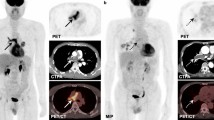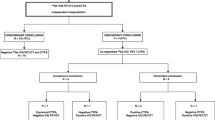Abstract
To determine the value of 18F-fluorodeoxyglucose (FDG) positron emission tomography/computed tomography (PET/CT) in differentiating malignancy of pulmonary artery (PA) from pulmonary thromboembolism (PTE) based on a larger number of cases by pooling our cases and those from the literature. Consecutive patients with a PA lesion who had undergone 18F-FDG PET/CT in our hospital were retrospectively reviewed. Moreover, PubMed, Embase, and Medline were searched for literature reporting individual maximum standardised uptake value (SUVmax) of the malignant PA lesion and/or PTE. 18F-FDG activity was compared between PA malignancy and PTE by pooling the data from literature and our patients. Receiver operating characteristic curve analysis was performed to determine the ability of SUVmax to differentiate PA malignancy from PTE. From our database, we identified 11 patients with pulmonary artery sarcoma (PAS), and nine cases of PTE. Fifty patients with a malignant PA lesion (40 cases of PAS and 10 cases of tumor embolism) and 22 subjects with PTE were extracted from the literature. In our cases, the SUVmax of PAS (11.1 ± 4.9, range: 5.5–19.9) was significantly higher than that of PTE (1.9 ± 0.6, range: 1.1–3.2; P < 0.001). There was no significant difference in the SUVmax between the literature data and our cases in malignant lesions or in PTE. Based on the pooled analysis of the literature data and our cases (61 cases of malignant lesions and 31 cases of PTE), the area under the curve for SUVmax to differentiate PA malignancy from PTE was 0.996 (95% CI: 0.989–1.000). At a cutoff value of 3.3, the sensitivity, specificity, and accuracy were 98.4%, 96.8%, and 97.8%, respectively. The 18F-FDG uptake value is an accurate index for determining PA malignancy.





Similar content being viewed by others
Abbreviations
- AUC:
-
Area under the curve
- CT:
-
Computed tomography
- CTPA:
-
CT pulmonary angiography
- FDG:
-
Fluorodeoxyglucose
- MRI:
-
Magnetic resonance imaging
- MRPA:
-
Magnetic resonance pulmonary angiography
- PA:
-
Pulmonary artery
- PAS:
-
Pulmonary artery sarcoma
- PET:
-
Positron emission tomography
- PTE:
-
Pulmonary thromboembolism
- ROC:
-
Receiver operating characteristic
- ROI:
-
Region of interest
- SUVmax :
-
Maximum standardised uptake value
References
Coli A, Parente P, Bigotti G (2007) Pulmonary artery sarcoma: an insidious tumor still diagnosed too late. Analysis of the literature and report of a case. J Exp Clin Cancer Res 26:151–156
Levy E, Korach A, Amir G, Milgalter E (2006) Undifferentiated sarcoma of the pulmonary artery mimicking pulmonary thromboembolic disease. Heart Lung Circ 15:62–63
Sandhu A, Yates TJ, Kuriakose P (2008) Pulmonary artery sarcoma mimicking a pulmonary embolism. Indian J cancer 45:27–29
Ito K, Kubota K, Morooka M, Shida Y, Hasuo K, Endo H et al (2009) Diagnostic usefulness of 18F-FDG PET/CT in the differentiation of pulmonary artery sarcoma and pulmonary embolism. Ann Nucl Med 23:671–676
Attina D, Niro F, Tchouante P, Mineo G, Russo V, Palazzini M et al (2013) Pulmonary artery intimal sarcoma. Problems in the differential diagnosis. Radiol Med 118:1259–1268
Chong S, Kim TS, Kim B-T, Cho EY, Kim J (2007) Pulmonary artery sarcoma mimicking pulmonary thromboembolism: integrated FDG PET/CT. Am J Roentgenol 188:1691–1693
Ishiguro T, Kasahara K, Matsumoto I, Waseda R, Minato H, Kimura H et al (2007) Primary pulmonary artery sarcoma detected with a pulmonary infarction. Intern Med 46:601–604
Lee EJ, Moon SH, Choi JY, Lee KS, Choi YS, Choe YS et al (2013) Usefulness of fluorodeoxyglucose positron emission tomography in malignancy of pulmonary artery mimicking pulmonary embolism. ANZ J Surg 83:342–347
Wittram C, Scott JA (2007) 18F-FDG PET of pulmonary embolism. Am J Roentgenol 189:171–176
Guo Y, Wang T, Yang M (2015) Pulmonary artery sarcoma detected on 18F-FDG PET/CT with unusual findings. Clin Nucl Med 40:e530–e531
Çelik G, Çiledaǧ A, Yüksel C, Yenigün BM, Kutlay H, Yazicioǧlu L et al (2011) Pulmonary artery sarcoma mimicking pulmonary thromboembolism. Tuberk Toraks 59:369–373
Chun IK, Eo JS, Paeng JC, Kim DW, Chung JK, Lee DS (2011) Pulmonary artery sarcoma detected on F-18 FDG PET/CT as origin of multiple spinal metastases. Clin Nucl Med 36:e87–e89
Desmarais P, Laskine M, Caporuscio C (2016) Primary pulmonary artery angiosarcoma mimicking pulmonary embolism in a 66-year-old man with dyspnea. CMAJ 188:E509–E512
Dias OM, Lombardi EM, Canzian M, Soares Junior J, Vieira Lde O, Terra Filho M (2011) 18F-fluorodeoxyglucose positron emission tomography as a noninvasive method for the diagnosis of primary pulmonary artery sarcoma. J Bras Pneumol 37:817–822
Evison M, Crosbie P, Chaturvedi A, Shah R, Booton R (2015) Pulmonary artery sarcoma: a rare thoracic tumor frequently misdiagnosed at presentation. Thorac Cancer 6:797–799
Girard N, Triby-Moreau C, Benabidallah S, Tronc F, Revel D, Giammarile F et al (2009) Pulmonary artery sarcoma, a paradigm of orphan thoracic oncology. Presse Med 38:1167–1170
Hajsadeghi S, Kooranifar S, Ansarinejad N, Sadeghipour A, Iranpour A, Aziz Ahari A (2017) Metastatic pulmonary artery sarcoma presented with tamponade: a case report. Clin Case Rep 5:1007–1010
Halank M, Jakob C, Kolditz M, Hoeffken G, Kappert U, Ehninger G et al (2010) Intimal pulmonary artery sarcoma presenting as severe dyspnea and right heart insufficiency. Onkologie 33:313–316
Hmelik S, Dobrenić M, Huić D (2018) F-18 FDG PET/CT in pulmonary artery sarcoma: clinical vignette. Nucl Med Rev 21:48–49
Inoue Y, Izumi Y, Sakaki K, Abe K, Oka T, Tamaru JI et al (2014) A case of pulmonary sarcoma with significant extension into the right lung. Case Rep Med 2014:279374
Kaira K, Imai H, Yamada M (2015) Recurrent intimal sarcoma mimicking pulmonary embolism. Jpn J Clin Oncol 45:695–696
Kamaleshwaran KK, Pattabiraman VR, Mehta S, Mohanan V, Shinto AS (2014) Spindle cell sarcoma of pulmonary artery mimicking thromboembolism with lung metastasis detected in fluorine-18 fluorodeoxyglucose positron emission tomography/computed tomography. Indian J Nucl Med 29:249–251
Kessler A, Son H (2015) Pulmonary artery angiosarcoma on 18F-FDG PET/CT masquerading as pulmonary embolism. Clin Nucl Med 40:82–84
Li J, Zhao Q, He L, Zhuang X, Li F (2016) Primary pulmonary artery sarcoma on dual-time point FDG PET/CT imaging. Clin Nucl Med 41:656–658
Liu X, Hou J, Wang X, Chen Z (2017) An intimal sarcoma of pulmonary artery mimicking pulmonary embolism: a case report and literature review. Respirol Case Rep 5:e00248
Min D, Lee JH, Jeong HC, Kim JH, Shin SP, Kim HM et al (2014) A case of pulmonary artery sarcoma presented as cavitary pulmonary lesions. Tuberc Respir Dis 76:136–140
Mori S, Uehara H, Motoi N, Okumura S (2017) Pulmonary artery sarcoma presenting as an isolated lung mass. Gener Thorac Cardiovasc Surg 65:171–174
Nakamura Y, Shimizu T, Fukumoto Y, Sugimura K, Ito S, Fujishima F et al (2012) A case of angiosarcoma arising in trunk of the right pulmonary artery clinically simulating pulmonary thromboembolism. World J Oncol 3:119–123
Oberson M, Sophie Pawelczak C, Meincke F (2010) Paraneoplastic thrombus or relapse of a pulmonary artery sarcoma? Thorax 65:941–942
Ote EL, Oriuchi N, Miyashita G, Paudyal B, Ishikita T, Arisaka Y et al (2011) Pulmonary artery intimal sarcoma: the role of 18F-fluorodeoxyglucose positron emission tomography in monitoring response to treatment. Jpn J Radiol 29:279–282
Park JS, Chung JH, Jheon S, Choi DJ, Yoon HI, Lee JH et al (2011) EBUS-TBNA in the differential diagnosis of pulmonary artery sarcoma and thromboembolism. Eur Respir J 38:1480–1482
Shingyoji M, Ikebe D, Itakura M, Nakajima T, Itami M, Kimura H et al (2013) Pulmonary artery sarcoma diagnosed by endobronchial ultrasound-guided transbronchial needle aspiration. Ann Thorac Surg 96:e33–e35
Strobel K, Bode B, Lardinois D, Exner U (2007) PET-positive fibrous dysplasia—a potentially misleading incidental finding in a patient with intimal sarcoma of the pulmonary artery. Skeletal Radiol 36(Suppl 1):S24–S28
Tueller C, Fischer Biner R, Minder S, Gugger M, Stoupis C, Krause TM et al (2010) FDG-PET in diagnostic work-up of pulmonary artery sarcomas. Eur Respir J 35:444–446
Yamasaki M, Sumi Y, Sakakibara Y, Tamaoka M, Miyazaki Y, Arai H et al (2011) Pulmonary artery leiomyosarcoma diagnosed without delay. Case Rep Oncol 4:287–298
Kumagai H, Nio K, Okumura Y, Komoda M, Shirakawa T, Kusaba H et al (2014) Successful chemoradiotherapy for undifferentiated malignant neoplasm arising from the left pulmonary artery. Case Rep Oncol 7:484–490
Hibino M, Akazawa K, Hikino K, Oe M (2012) Pulmonary tumor embolism secondary to uterine corpus carcinosarcoma mimicking pulmonary thromboembolism. Intern Med 51:2603–2607
Leuzzi G, Melis E, Forcella D, Facciolo F (2015) Pulmonary tumor embolus with high (18) FDG uptake mimicking lung metastasis from renal-cell cancer. Rev Esp Med Nucl Imagen Mol 34:325–326
Purandare NC, Dua SG, Rangarajan V, Shah S, Sharma AR (2010) Pulmonary artery and femoral vein tumour thromboembolism in a patient with osteogenic sarcoma demonstrated by FDG PET/CT. Eur J Nucl Med Mol Imaging 37:653
Sone T, Yoshikawa K, Fukunaga M (2008) Pulmonary tumor embolism from choriocarcinoma: detection with F-18 FDG positron emission tomography. Clin Nucl Med 33:773–774
Vial MR, Sarkiss M, Lazarus DR, Eapen G (2015) Endobronchial ultrasound-guided diagnosis of pulmonary artery tumor embolus. Ann Thorac Surg 99:1816–1819
Zaheer S, Osmany S, Lai HK, Eng DNC (2009) Usefulness of F-18 fluorodeoxyglucose positron emission tomography/computed tomography in a case of choriocarcinoma presenting as pulmonary embolism. Clin Nucl Med 34:343–345
Flavell RR, Behr SC, Brunsing RL, Naeger DM, Pampaloni MH (2014) The incidence of pulmonary embolism and associated FDG-PET findings in IV contrast-enhanced PET/CT. Acad Radiol 21:718–725
Manoharan P, Cronin PP, Brown RK (2007) Metastatic head and neck cancer conflated with pulmonary embolism and infarct on PET/CT. Radiol Case Rep 2:62
Restrepo CS, Betancourt SL, Martinez-Jimenez S, Gutierrez FR (2012) Tumors of the pulmonary artery and veins. Semin Ultrasound CT MR 33:580–590
Hoiczyk M, Iliodromitis K, Bauer S, Konorza T, Philipp S, Bankfalvi A et al (2012) Intimal sarcoma of the pulmonary artery with unusual findings: a case report. Clin Res Cardiol 101:397–401
Lee DH, Jung TE, Lee JH, Shin DG, Park WJ, Choi JH (2013) Pulmonary artery intimal sarcoma: poor 18F-fluorodeoxyglucose uptake in positron emission computed tomography. J Cardiothorac Surg 8:40
Watanabe K, Shinkai M, Kaneko T (2016) Autopsy case of pulmonary artery sarcoma forming aneurysm without FDG uptake. Arch Bronconeumol 52:535–536
Kishimoto N, Ikuta T, Fujii H, Sumiya A, Kimura E, Shimizu Y (2018) Pyogenic granuloma originating in the pulmonary artery. Gen Thorac Cardiovasc Surg. https://doi.org/10.1007/s11748-018-0930-1
Tanaka I, Masuda R, Inoue M, Kasahara D, Furuhata Y, Shimizu S et al (1994) Primary pulmonary-artery sarcoma. Report of a case with complete resection and graft replacement, and review of 47 surgically treated cases reported in the literature. Thorac Cardiovasc Surg 42:64–68
Fernandes T, Planquette B, Sanchez O, Morris T (2016) From acute to chronic thromboembolic disease. Ann Am Thorac Soc 13(Suppl 3):S207–S214
Author information
Authors and Affiliations
Corresponding author
Ethics declarations
Conflict of interest
All authors declared that they have no conflict of interest.
Additional information
Publisher’s Note
Springer Nature remains neutral with regard to jurisdictional claims in published maps and institutional affiliations.
Rights and permissions
About this article
Cite this article
Xi, XY., Gao, W., Gong, JN. et al. Value of 18F-FDG PET/CT in differentiating malignancy of pulmonary artery from pulmonary thromboembolism: a cohort study and literature review. Int J Cardiovasc Imaging 35, 1395–1403 (2019). https://doi.org/10.1007/s10554-019-01553-5
Received:
Accepted:
Published:
Issue Date:
DOI: https://doi.org/10.1007/s10554-019-01553-5




